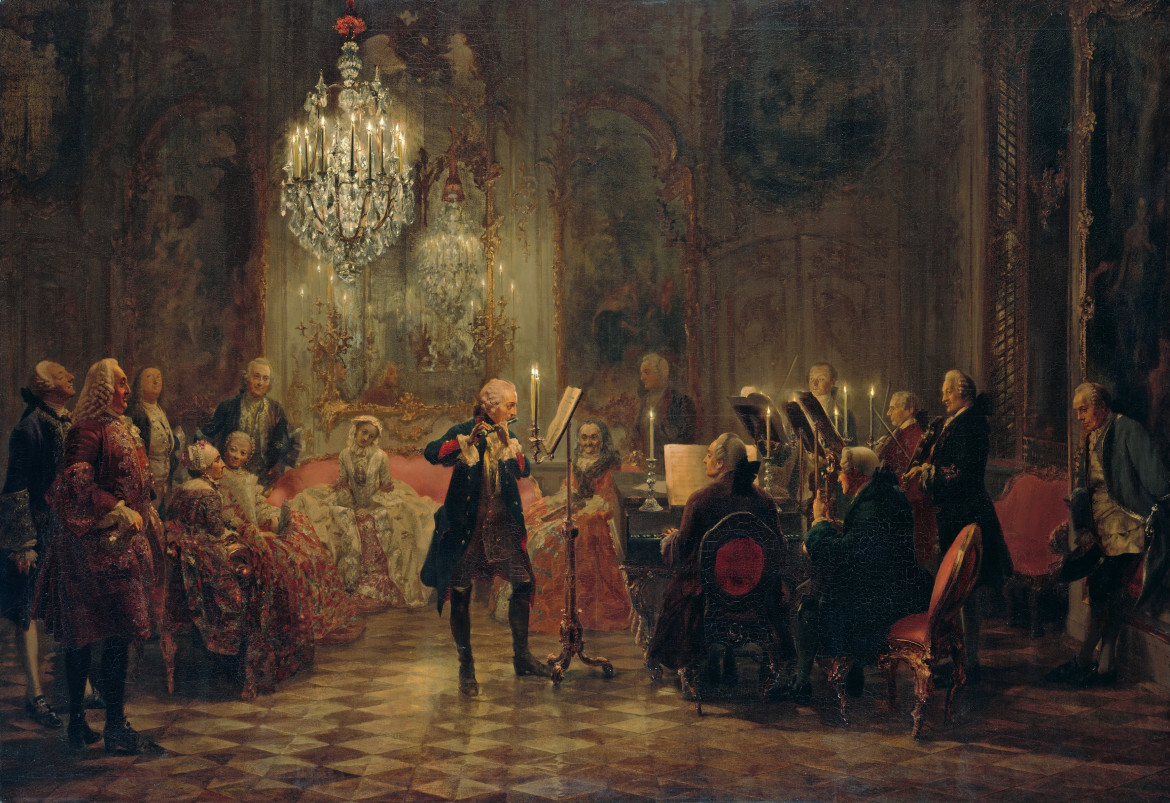Why chamber music deserves a place on classical playlists

"Adolph Menzel - Flötenkonzert Friedrichs des Großen in Sanssouci - Google Art Project" by Adolph Menzel - WAFEF2zy8Ym8vQ at Google Cultural Institute, zoom level maximum. Licensed under Public Domain via Commons.
This essay originally appeared on the blog Scanning the Dial and is republished here with permission of the author.
We often say that radio is one of the most intimate of all media. Classical radio, in particular, fits the bill: When I’m on the air, I don’t like to imagine that I’m speaking to hundreds or thousands of people at any given moment, but rather just a small group of people who are sharing in the listening experience.
Intimacy (in the strictly platonic sense) has been an important part of music for centuries. If you look at the majority of works written by the great composers, it’s chamber music. Think about it: Of the 600+ works written by Mozart, only 41 were symphonies. Add in his various concertos, larger divertimenti, ballets and opera, and his symphonic output might come out to around 20–25% of his total output.
The rest is chamber music: solo piano works, string quartets, songs and other goodies. Mozart’s chamber music is also where he could really put his imagination to the best possible use, as he was free of the formal constraints that were placed on him by those who paid for and attended performances of his larger works. The same goes for Beethoven (nine symphonies, seven concertos, plus various ballets/operas), Brahms (four symphonies, four concertos, a couple of serenades, Haydn Variations, and a few choral/orchestral works), Dvorak (nine symphonies, three concertos, some tone poems and concert overtures, Symphonic Variations, Slavonic Dances, and a few operas), and on and on and on.
Chamber music is becoming the vehicle of choice for contemporary classical musicians to build audiences as well. The Cleveland Orchestra has experimented with having its members play chamber music in bars. Groupmuse is a collective of musicians that brings classical music to private homes for parties and other social gatherings. The list of chamber music groups and festivals springing up across the country is too big to list here, but with the struggles of orchestras these days, more and more musicians are turning to the intimate side of classical music to make a case for their relevance.
It only seems natural to me that this amazing music should find its way on to classical music radio playlists. But for the most part, it doesn’t. Scanning playlists from various stations, I found that save for the odd Mozart or Haydn quartet, the very occasional “Trout” Quintet, and a few random violin sonatas, stations are very reluctant to program some of the most powerful music ever written.
If I do find this music — and it’s rare — it’s either buried late in the evening or overnight, or it’s part of syndicated programs like Performance Today and others. And I understand the reasons: “It has too large of a dynamic range,” “It’s not instantly recognizable” or “It doesn’t test as well in focus groups.” All are very valid points, but if you’re a savvy programmer and can find ways to place some of this amazing music in the proper context and with the right introduction, you have the potential to greatly expand the palette of music your station offers.
Here are some pieces of chamber music I’d challenge other programmers to add to their playlists. It is by no means a complete list, but these pieces happened to be the first ones that popped into my head.
Strings/piano
Mendelssohn: Cello Sonata No. 2 in D, Op. 58
I got to know Mendelssohn’s two sparkling cello sonatas while recording them with my two friends Ben Capps and David Kaplan at Vermont Public Radio. What strikes me is how just two instruments can create such a full, almost orchestral sound. And then there’s that trademark effervescence for which Mendelssohn is so beloved. Here’s the final movement of the second cello sonata — consider adding it to your playlist!
Dvorak: Piano Trio No. 3 in F Minor, Op. 65
This is one of the most intensely beautiful pieces of music I’ve ever encountered. It has everything: an expansive opening movement, a dream-like scherzo, a poignant slow movement, and a riveting dance-rondo finale. Here’s a video of the fourth movement — tell me, who wouldn’t enjoy this?
Schumann: Piano Quartet in E-flat, Op. 47
This piece is likely on a lot of folks’ radar already, but it’s not one I see showing up on classical radio playlists that often. And it puzzles me as to why — after all, it’s immediately accessible, exciting, and features an absolutely gorgeous slow movement that is sure to stop many people in their tracks.
Winds/piano
Beethoven: Clarinet Trio in B-flat, Op. 11 “Gassenhauer”
What a ridiculously fun piece, ending with a set of variations on an aria from an opera by Joseph Weigl. Who’s that? I have no idea, but evidently this tune was all the rage in Vienna when Beethoven wrote this trio, so that’s where it gets the nickname “Gassenhauer,” or “street tune.” The rest of the piece is fun, too, and the combination of clarinet, cello and piano is a fun one that radio listeners don’t get to hear that often.
Durufle: Prelude, Recitatif, and Variations for Flute, Viola, and Piano, Op. 3
Maurice Durufle is mainly known for writing incredibly difficult organ music, as well as some remarkably beautiful sacred choral music (Gregorian motets and Requiem). But he also wrote this magnificent work. It starts somewhat nebulously, but soon breaks out into the light and sounds a lot like Debussy and Ravel. Not great for drive time, perhaps, but a beautiful piece for the midday. Have a listen!
Strings/winds
Jean Cras: Quintet for Flute, Harp, and Strings
I was first introduced to this piece by my friend Ariel Rudiakov, a violist and artistic director of the Manchester Music Festival in Vermont. I had never heard of the composer, let alone this piece, but was absolutely delighted to hear it for the first time. It doesn’t require a deep level of listening to be enjoyable, but those who do listen closely will be rewarded with all kinds of fun textures. Great for midday programming.
Spohr: Nonet in F, Op. 31
It’s like a symphony boiled down to each individual instrument! Great fun, happy music. Give it a try.
These pieces are just the tip of the iceberg. There are so many great pieces of chamber music out there that deserve to be heard on the radio. Just find the courage to program them!








